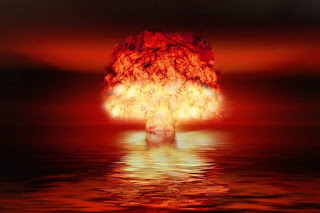The Atomic Bomb
Original Passage :
Informal Passage :The atomic bomb, like many groundbreaking inventions, was invented during a time of war. Back in the 1940s, there was a race to see who could develop this powerful weapon first: the Axis Powers (Germany, Italy, and Japan) or the Allied Powers (the United States, England, and France). For many, it seemed almost inevitable that someone would eventually conquer this tremendous energy source of nuclear fission for warfare.
The main scientific discovery that led the way for the atomic bomb discovery occurred in 1934 when Enrico Fermi, the Italian physicist, started experimenting with uranium, mainly trying to split it using neutrons. This process, known as nuclear fission, involves a neutron causing a large nucleus like uranium to break into two roughly equal pieces, releasing a huge amount of energy. Each time a uranium-235 nucleus undergoes fission(breaks apart) it releases a massive 100 million times more energy than a regular chemical reaction.
The significance of these discoveries didn't go unnoticed by the scientific community. By the 1930s, the clouds of death and the need for power of World War II were rising over Europe. Some scientists saw the potential for an explosive weapon based on nuclear fission, an atomic bomb. Fortunately, for history's sake, the main reason for why we are alive now, most of the German and Italian scientists working on this were forced to flee their homelands. This prevented Adolf Hitler and the Nazis from getting their hands on this powerful weapon.
In early 1939, a group of nuclear scientists became convinced that the United States needed to start developing an atomic bomb. They managed to persuade the physicist Albert Einstein to write a letter to President Roosevelt, explaining the concept of the bomb and urging a national effort for its development. However, the U.S. government didn't move swiftly on Einstein's recommendation. Even as late as 1943, less than $300,000 had been allocated for the development of an atomic bomb.
It wasn't until 1942, that a serious program to build an atomic bomb started. President Roosevelt finally gave the green light for the creation of the Manhattan Project. This project had a codename, "Manhattan" and was housed within the Army Corps of Engineers. Its mission was to develop the atomic bomb.
One of the major problems the project faced was producing enough fissionable material for the bomb. To create a nuclear explosion, a huge mass of uranium was required to make each bomb so that it initiates the chain reaction. Researchers explored different methods for producing this uranium material, and they established a special laboratory at Oak Ridge, Tennessee, just for this purpose. Additionally, they began researching the production of plutonium-239, a synthetic material that's also similar to sustaining a fission reaction.
So, amid WW2, the seeds of a powerful invention were sown, and the Manhattan Project became the center of an important scientific and engineering effort to harness the power of nuclear fission for both destructive and constructive purposes.






Comments
Post a Comment